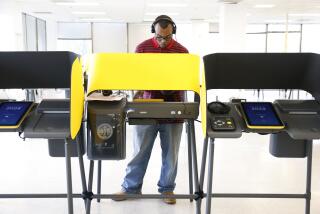Appeals court upholds Washington state’s open primary system
In a decision that could foreshadow survival of California’s new “top two” primary system, the U.S. 9th Circuit Court of Appeals on Thursday upheld a similar Washington state ballot initiative that changed the way voters choose candidates in primaries.
Both states’ voters approved measures allowing the top two vote-getters in a primary to advance to the general election, regardless of party affiliation. The format replaced closed primaries, in which each party chose a candidate for the general election.
The Washington law, which was approved in 2004 and went into effect in 2008, was challenged by the state’s Republican, Democratic and Libertarian parties on grounds that it limited their constitutional right of association by taking away their authority to choose their candidates.
The political parties also alleged that the new system confused voters because each primary candidate is identified by his or her preferred party affiliation, leaving the impression that the party had endorsed him or her.
A three-judge panel of the 9th Circuit, which hears cases from a nine-state region including California, unanimously rejected those arguments from the Washington plaintiffs.
“There is nothing inherently misleading about equating a candidate’s self-declared party preference with party affiliation. ... In light of the clear language of the ballot, the voters’ pamphlet and the ballot insert, no reasonable voter would be confused,” the appellate panel wrote.
California’s “top two” primary format took effect last year, after voters passed Proposition 14 in 2010. Challenges are pending in state and federal court. In August, a federal judge dismissed a suit filed by minor parties that cited the same grounds as the Washington case. That case is under appeal to the 9th Circuit.
The ruling on the Washington case makes it “extremely likely” that the California primary system also will be deemed constitutional, said Richard Hasen, professor of election law at UC Irvine. He noted that California’s plan was modeled after Washington’s and that similar nonpartisan primaries had passed federal court review elsewhere in the country.
“The position of people who support ‘top two’ primaries is that it will produce more moderate candidates, because you get a lot of crossover voting,” Hasen said.
The idea is that when voters can cross party lines they are likely to reduce the chances that each party’s most partisan members will select an uncompromising candidate. In theory, both general election candidates could be from the same party.
Opponents’ argument that the change hurts minor party candidates’ chances of making the general election ballot aren’t persuasive, Hasen said, because “they already have such a tough road that this doesn’t make that much difference.”
One potential practical flaw in California’s system is its exclusion of write-in candidates from the general election, Hasen said. That could leave voters with no real choice in the event of some last-minute scandal or misfortune affecting one of the two successful primary candidates, he said.
California Republicans and Democrats also have looked askance at the “top two” primary. The GOP leadership has talked about circumventing the system by polling its members before the June 5 primary to identify and endorse a preferred candidate.
Those challenging the California primary format have asked the courts to rule by March 29 to give state officials time to revert to a closed primary if the courts find “top two” to be constitutionally flawed.
More to Read
Start your day right
Sign up for Essential California for news, features and recommendations from the L.A. Times and beyond in your inbox six days a week.
You may occasionally receive promotional content from the Los Angeles Times.







